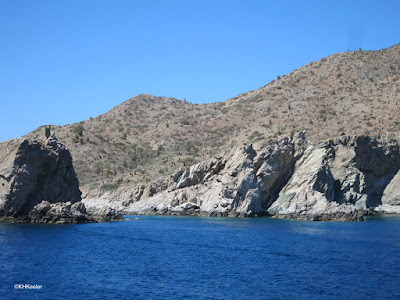 |
| island: Gulf of California |
From the moment I stepped out of the airport at San José del Cabo at the tip of the Baja California peninsula, the landscape was exotic:
The peninsula has a variety of climates, dry to extremely dry, hot to warm, some areas receiving summer rain, some with winter rain, all depending on exactly where you are. I saw only a sampling of it.
If you’ve been to the desert around Phoenix, Arizona, you’ve seen something like it. Deserts in this part of North America are very old. Baja California is in the core of this zone, with the most extreme, oldest desert and consequently with some of the strangest plants.
Strange to look at, well-adapted to heat and drought.
 |
| the cardón cactus |
The cardón is the tallest and most massive of all cacti.
 |
| More cardón cacti |
 |
| Hillside with cardón cacti |
And there were other wonderful plants.
But also this (below), the coyote melon (Cucurbita cordata, cucumber family Cucurbitaceae), a wild squash with a huge root. Below you see the top of the root sticking out of the ground. I didn’t see live leaves or flowers, only the root waiting to put out leaves when the winter rains come. It is endemic to (found only in) Baja California.
 |
| coyote melon root top (whitish) |
 |
| dog poop bush |
In addition to stabbing you, the plants often had very intense odors, which I can't show in a blog post. Presumably those odors were from strong chemicals in the leaves, warning you that a stomach-full would produce severe indigestion.
The plant below is the giganta elephant tree, Bursera odorata (the torchwood family, Burseraceae, a tropical family of more than 500 species). The genus Bursera has 110 species of which more than 80 species occur in Mexico. Of the Mexican species, 90% are endemic to Mexico. The giganta elephant tree is endemic to Baja California Sur, the Mexican state at the southern end of Baja California.
 |
| giganta elephant tree, Bursera odorata |
I think I walked by the giganta elephant tree the first couple times without paying much attention, thinking the plants were sick or injured. But in fact, this is how they grow. They are rarely more than 4’ (1.3 m) high! In another season there will be leaves and flowers.
Scenes like the above photo are common in Baja California, terrifically strange for people who are used to forests of pines or hardwoods (Photos to contrast Florida pine forest, California north of San Francisco, eastern forest Delaware)
I knew odd plants had adapted to the harsh conditions of Baja California but seeing them was a revelation--they were indeed spectacular.
More in future posts.
Comments and corrections welcome.
References
Rebman, J. P. and N.C.Roberts. 2012. Baja California Plant Field Guide. 3rd ed. San Diego Natural History Museum San Diego
Thanks also to Lindblad/National Geographic guide Gretchen Pederson, without whom I couldn’t have identified coyote melon (no leaves, flowers or fruits) and would have been a lot longer looking up some of the other plants.
related post: another American desert plant agave
related posts: about spines about poisonous plants
Kathy Keeler
More at awanderingbotanist.com
Join me on Facebook: https://www.facebook.com/AWanderingBotanist




Your image of the Coyote Melon is actually the species Ibervillea sonorae, not Cucurbita cordata. The first is a woody perennial vine while the latter is an herbaceous perennial with a deep taproot. Check out my botany blogs at www.lasecomujeres.org
ReplyDelete